 W
WA windmill is a structure that converts wind power into rotational energy by means of vanes called sails or blades, specifically to mill grain (gristmills), but the term is also extended to windpumps, wind turbines and other applications. The term wind engine is sometimes used to describe such devices.
 W
WBeebe Windmill is a historic mill located at the southeast corner of Ocean Road and Hildreth Avenue in Bridgehampton, New York.
 W
WThe Ben Darrah Water Tank and Well House near Shoshone, Idaho, United States, were built in c. 1916 by stonemason Bill Darrah. They was listed on the National Register of Historic Places in 1983; the listing included two contributing buildings on 1.3 acres (0.53 ha).
 W
WEstate La Reine, near Christiansted on St. Croix in the U.S. Virgin Islands, dates from around 1750. It was listed on the National Register of Historic Places in 1980. The listing included three contributing buildings, two contributing structures, and a contributing site.
 W
WEstate Mount Victory, near Frederiksted on Saint Croix in the U.S. Virgin Islands, was listed on the National Register of Historic Places in 1978. The listing included five contributing sites on 7 acres (2.8 ha).
 W
WGardiners Island Windmill is a historic windmill on Gardiners Island in East Hampton, New York.
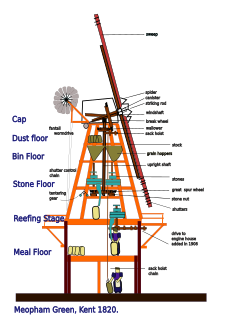 W
WThis glossary of mill machinery covers the major pieces of machinery to be found in windmills, watermills and horse mills. It does not cover machinery found in modern factories.
 W
WHayground Windmill is an historic windmill at Windmill Lane in East Hampton Village, New York. It was moved from Hayground to Pantigo between Two Mile Hollow Beach and Egypt Beach in the 1950s.
 W
WHook Windmill, also known as Old Hook Mill, is a historic windmill on North Main Street in East Hampton, New York. It was built in 1806 and operated regularly until 1908. One of the most complete of the existing windmills on Long Island, the windmill was sold to the town of East Hampton in 1922. The building was listed on the National Register of Historic Places in 1978 and is part of the North Main Street Historic District. The mill was renamed the "Old Hook Mill" and is open daily to visitors. The Windmill is among the 11 other surviving 18th and early 19th century wind-powered gristmills located on Long Island. It was built by Nathaniel Dominy V, a well-known East Hampton craftsman.
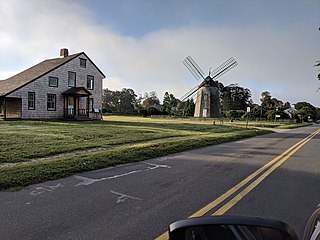 W
WThe mill cottage on the Lion Gardiner farm at 36 James Lane on the landmarked East Hampton Village green has become a museum displaying 19th and early-20th-century landscape paintings. It is a contributing structure on the NRHP East Hampton Village District, replacing the original cottage on the lot situated with the windmill and Rev James historic marker.
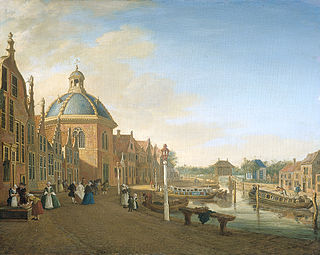 W
WPaulus Constantijn la Fargue, also Constantine Paul Lafargue, was a Dutch painter, etcher and draftsman.
 W
WThe Lamour Watermill (French: Le Moulin Lamour) is a museum and arts centre located in Briastre, Hauts-de-France, France. The water-powered mill and its edifices were built in the year 1800. It was originally used for milling grain but fell into disuse in the 1930s before being converted into a museum by the Belleval family in the late 1990s.
 W
WThis is a list of windmills in the American state of New York.
 W
WThe Mills Archive was established in 2002 to preserve and protect records of milling heritage and to make them freely available to the public. It is governed by the Mills Archive Trust, which is a charity that is based at Watlington House, Reading, Berkshire, England.
 W
WMulford Farm in East Hampton, Long Island, New York, is one of America's most significant, intact English colonial farmsteads. The farmhouse was built in 1680 by High Sheriff Josiah Hobart, an important early official of the first New York Royal Province government. Samuel "Fish Hook" Mulford bought the property in 1712 after Hobart's death. He had the barn built in 1721. The property is listed as a contributing property of the East Hampton Village District, a historic district listed on the National Register of Historic Places.
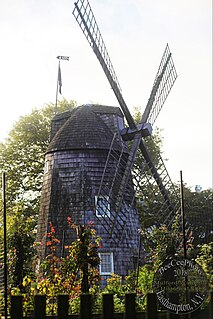 W
WThe Pantigo Windmill on James Lane in Easthampton, New York is a smock mill with eight sides, bearing a weathervane on top with 1771 punched through it. The structure was added to the National Register of Historic Places in 1984 as a contributing property of the East Hampton Village District.
 W
WThe post mill is the earliest type of European windmill. Its defining feature is that the whole body of the mill that houses the machinery is mounted on a single vertical post, around which it can be turned to bring the sails into the wind. All post mills have an arm projecting from them on the side opposite the sails and reaching down to near ground level. With some, as at Saxtead Green, the arm carries a fantail to turn the mill automatically. With the others the arm serves to rotate the mill into the wind by hand.
 W
WThe Robert M. Lamp Cottage, also known as Rocky Roost, was a summer cottage on a small island on Lake Mendota in Madison, Wisconsin. The cottage was designed by architect Frank Lloyd Wright for boyhood friend, Robert M. Lamp (1866–1916), for whom Wright also designed the Lamp House in Madison.
 W
WThe Romeo and Juliet Windmill is a wooden structure designed by architect Frank Lloyd Wright in the town of Wyoming, Wisconsin. The building is on the Taliesin estate and was declared a National Historic Landmark in 1976.
 W
WThe Alexander & Anna Schwartz Farm, located at 57 E. Rd. 70 in Dighton, Kansas, was listed on the National Register of Historic Places in 2014.
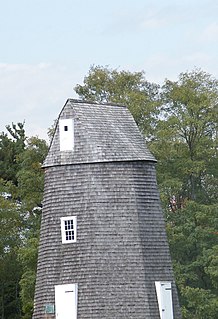 W
WShelter Island Windmill is an historic windmill north of Manwaring Road in Shelter Island, Suffolk County, New York. It was built in 1810. The windmill has been on Shelter Island since 1840, in its current location in 1926, and has been on the Sylvester Manor farm ever since.
 W
WThe smock mill is a type of windmill that consists of a sloping, horizontally weatherboarded, thatched, or shingled tower, usually with six or eight sides. It is topped with a roof or cap that rotates to bring the sails into the wind. This type of windmill got its name from its resemblance to smocks worn by farmers in an earlier period.
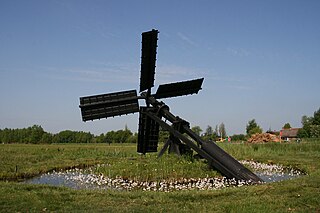 W
WThe tjasker is a small type of windmill used solely for drainage purposes. It is distinctive for its simple construction, featuring only a single inclined shaft that carries the sails on one end and an Archimedes' screw on the other, in this way avoiding the need for any gearing. The tjasker is commonly known as a typical Frisian windmill though it is also found in other Dutch provinces and in north Germany.
 W
WA tower mill is a type of vertical windmill consisting of a brick or stone tower, on which sits a wooden 'cap' or roof, which can rotate to bring the sails into the wind.
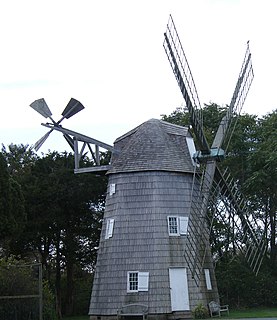 W
WWainscott Windmill is an historic windmill on Georgica Association grounds in Wainscott, New York in the Town of East Hampton. Georgica Association grounds are both within Wainscott and the Village of East Hampton to the east.
 W
WWind rights are rights relating to windmills, wind turbines and wind power. Historically in Continental Europe wind rights were manorial rights and obligations relating to the operation and profitability of windmills. In modern times, as wind becomes a more important source of power, rights relating to wind turbines and windmills are sometimes referred to as "wind rights".
 W
WThe windmill at Ruprechtov, dating from the 1870s, is one of the most important and unique technical monuments in the Czech republic, from the historical and technical point of view, it is equipped with the Halladay patent turbine, the only machine of this type in the Czech Republic and in Europe.
 W
WCorwith Windmill at Water Mill is a historic mill on NY 27 and Halsey Lane in Southampton, New York.
 W
WA fantail is a small windmill mounted at right angles to the sails, at the rear of the windmill, and which turns the cap automatically to bring it into the wind. The fantail was patented in 1745 by Edmund Lee, a blacksmith working at Brockmill Forge near Wigan, England, and perfected on mills around Leeds and Hull towards the end of the 18th century. Fantails are found on all types of traditional windmills and are especially useful where changes in wind direction are frequent. They are more common in England, Denmark and Germany than in other parts of Europe, and are little-known on windmills elsewhere except where English millwrighting traditions were in evidence.
 W
WThe Windmills of Corvo is a group of windmills located in the municipality of Vila do Corvo, island of Corvo, in the Portuguese archipelago of the Azores.
 W
WA windpump is a type of windmill which is used for pumping water.